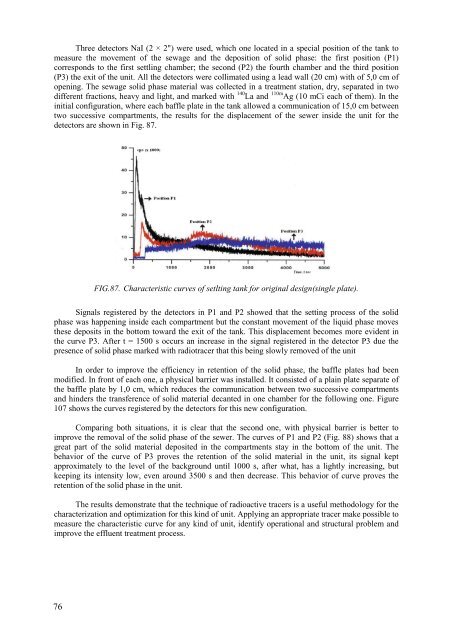Download file - Ayuntamiento de Zaragoza
Download file - Ayuntamiento de Zaragoza
Download file - Ayuntamiento de Zaragoza
You also want an ePaper? Increase the reach of your titles
YUMPU automatically turns print PDFs into web optimized ePapers that Google loves.
Three <strong>de</strong>tectors NaI (2 × 2") were used, which one located in a special position of the tank tomeasure the movement of the sewage and the <strong>de</strong>position of solid phase: the first position (P1)corresponds to the first settling chamber; the second (P2) the fourth chamber and the third position(P3) the exit of the unit. All the <strong>de</strong>tectors were collimated using a lead wall (20 cm) with of 5,0 cm ofopening. The sewage solid phase material was collected in a treatment station, dry, separated in twodifferent fractions, heavy and light, and marked with 140 La and 110m Ag (10 mCi each of them). In theinitial configuration, where each baffle plate in the tank allowed a communication of 15,0 cm betweentwo successive compartments, the results for the displacement of the sewer insi<strong>de</strong> the unit for the<strong>de</strong>tectors are shown in Fig. 87.FIG.87. Characteristic curves of setlting tank for original <strong>de</strong>sign(single plate).Signals registered by the <strong>de</strong>tectors in P1 and P2 showed that the setting process of the solidphase was happening insi<strong>de</strong> each compartment but the constant movement of the liquid phase movesthese <strong>de</strong>posits in the bottom toward the exit of the tank. This displacement becomes more evi<strong>de</strong>nt inthe curve P3. After t = 1500 s occurs an increase in the signal registered in the <strong>de</strong>tector P3 due thepresence of solid phase marked with radiotracer that this being slowly removed of the unitIn or<strong>de</strong>r to improve the efficiency in retention of the solid phase, the baffle plates had beenmodified. In front of each one, a physical barrier was installed. It consisted of a plain plate separate ofthe baffle plate by 1,0 cm, which reduces the communication between two successive compartmentsand hin<strong>de</strong>rs the transference of solid material <strong>de</strong>canted in one chamber for the following one. Figure107 shows the curves registered by the <strong>de</strong>tectors for this new configuration.Comparing both situations, it is clear that the second one, with physical barrier is better toimprove the removal of the solid phase of the sewer. The curves of P1 and P2 (Fig. 88) shows that agreat part of the solid material <strong>de</strong>posited in the compartments stay in the bottom of the unit. Thebehavior of the curve of P3 proves the retention of the solid material in the unit, its signal keptapproximately to the level of the background until 1000 s, after what, has a lightly increasing, butkeeping its intensity low, even around 3500 s and then <strong>de</strong>crease. This behavior of curve proves theretention of the solid phase in the unit.The results <strong>de</strong>monstrate that the technique of radioactive tracers is a useful methodology for thecharacterization and optimization for this kind of unit. Applying an appropriate tracer make possible tomeasure the characteristic curve for any kind of unit, i<strong>de</strong>ntify operational and structural problem andimprove the effluent treatment process.76
















